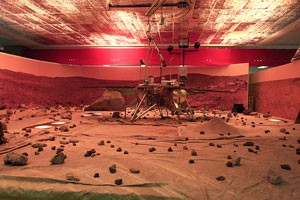If you are currently worrying about failing your finals, put yourself in Peter Smith’s shoes. His multi-million-dollar spacecraft is cruising at 74,000 mph and is less than four million miles away from the surface of Mars.
“”I can think of 100 ways we could fail,”” said Smith, the principal investigator of the UA-led Phoenix Mars Lander mission. “”On the other hand, we’ve been thinking about these 100 ways we could fail for the past three years, and we think we have the lowest-risk entry vehicle we could possibly have.””
The lander is less than 18 days away from its long-awaited landing on the Red Planet. At that point, it will begin testing soil to determine whether there was ever liquid water on Mars.
“”It’s thrilling. It is a truly historic event,”” Smith said. “”Nobody can predict how our pictures are going to look when we get there. It’s the thrill of exploration.””
The lander is scheduled to reach the surface at around 4:50 p.m. May 25, “”then the control goes to the U of A at our operations center on Sixth Avenue,”” Smith said. “”That’s where the surface operations team will be ready to go.””
Smith will be watching the mission from the Jet Propulsion Lab with UA President Robert Shelton and California Gov. Arnold Schwarzenegger.
The public is invited to watch the landing on the UA Mall, starting at 3 p.m.
Back in Tucson, the ground team will go to work getting the lander’s instruments, most of which have never flown in space, up and running for several days before any science can start, Smith said.
“”In the meantime we’ll have lots of pictures to show because the camera will be functioning right away,”” he said. “”Then we start gathering samples and analyzing them on our instruments, and that’s where you really start to learn some new things about Mars.””
The lander will look for salt and organic material in the soil, which would indicate that ice had melted, Smith said.
The UA was selected for this mission in August 2003. Smith has been working on other Mars spacecraft since 1997, when he helped build the camera for Pathfinder and worked on the failed Mars Polar Lander in 1999.
“”I’ve seen both the highs and the lows of landing on Mars,”” Smith said. “”So we expect a huge success May 25.””
“”Failure is not an option,”” he added. “”Unfortunately, it is a risk.””
Failure is always a possibility because of the complex transformations the lander must undergo as it morphs from a space cruiser to a surface-ready laboratory, all while descending, Smith said.
“”We think we’ve done enough testing and enough analysis that the likelihood is small that we’ll do something wrong,”” Smith said. “”The scariest part is that if even one thing fails to happen, then you’re finished. Everything is crucial and critical.””
Once the lander touches down, its solar panels will expand, its instruments will come to life, and it will start sending pictures back to the waiting crowd on earth.
“”It’s almost like a human,”” Smith said. “”We have the ability to taste and to smell and to see and to feel.””
Over this year, the lander has had three planned trajectory course maneuvers and went into safe mode once, but it was restored with a cold reboot.
“”It wasn’t a big deal,”” Smith said about the problem. “”We did kind of what you do with your home computer – we turned it off and restarted it and everything was all right.””
The UA is the first publicly funded institution to lead a mission to Mars.
The total cost of the mission is about $420 million, and the UA is expected to reap $50 to $60 million, one third of which goes to the university overhead.
Shelton did not respond to an e-mail seeking comment.
“”They’ve been extremely supportive all along the way,”” Smith said about the UA. “”That really makes me proud that they’ll step up and support a project like this.””
Smith said he hopes to do more missions to get more research dollars and give better opportunities to the students attending the UA.
About 25 students currently work on the Phoenix mission, and Smith called them “”indispensable.””
It’ll be up to another mission to figure out if there’s something living on Mars because the lander doesn’t test for DNA, Smith said.
“”We see ourselves as a stepping stone on the search for life on Mars, taking that next important step seeing if life could exist,”” he said.









